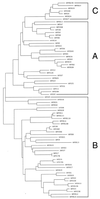Persistence of human papillomavirus DNA in benign and (pre)malignant skin lesions from renal transplant recipients
- PMID: 10834958
- PMCID: PMC86734
- DOI: 10.1128/JCM.38.6.2087-2096.2000
Persistence of human papillomavirus DNA in benign and (pre)malignant skin lesions from renal transplant recipients
Abstract
An extremely diverse group of human papillomavirus (HPV) types consisting of epidermodysplasia verruciformis (EV)-associated HPV types and other cutaneous HPV types (e.g., HPV types 2 and 3) is associated with nonmelanoma cancers and benign lesions of the skin. The frequent presence of multiple HPV types in single skin biopsy specimens of renal transplant recipients prompted us to develop PCR techniques for the detection of distinct (sub)groups of genotypically related cutaneous HPV types, i.e., three subgroups of EV-associated HPV types and two groups (A2 and A4) of other cutaneous HPV types. This approach generally allowed a reliable identification of HPV genotypes by direct sequencing of the PCR products, despite the frequent occurrence of multiple infections. The targeted spectrum of HPV types comprises 66 cutaneous HPV types including 21 putative novel HPV types. We also detected 17 putative novel HPV subtypes. We demonstrated that the skin of nearly all renal transplant recipients who developed various benign and (pre)malignant skin lesions was persistently infected with one or more EV-associated HPV types and/or HPV types belonging to groups A2 and A4. The frequency and distribution of EV-associated HPV and HPV types belonging to groups A2 and A4 were similar in biopsy specimens from hyperkeratotic papillomas (77.5%), squamous cell carcinomas (77. 8%), and actinic keratoses (67.9%) but appeared to be lower in specimens of basal cell carcinomas (35.7%), benign lesions (38.5%), and clinically normal skin (32.3%). These findings suggest that renal transplant recipients are prone to persistent cutaneous HPV infection. Our data do not support the existence of high-risk cutaneous HPV types.
Figures


References
-
- Berkhout R J, Tieben L M, Smits H L, Bouwes Bavinck J N, Vermeer B J, ter Schegget J. Nested PCR approach for detection and typing of epidermodysplasia verruciformis-associated human papillomavirus types in cutaneous cancers from renal transplant recipients. J Clin Microbiol. 1995;33:690–695. - PMC - PubMed
-
- Boxman I L, Berkhout R J, Mulder L H, Wolkers M C, Bouwes Bavinck J N, Vermeer B J, ter Schegget J. Detection of human papillomavirus DNA in plucked hairs from renal transplant recipients and healthy volunteers. J Investig Dermatol. 1997;108:712–715. - PubMed
-
- Boxman I L A, Russell A, Mulder L H C, Bouwes Bavinck J N, ter Schegget J, Green A the Nambour Skin Cancer Prevention Study Group. Case-control study in a subtropical Australian population to assess the relation between non-melanoma skin cancer and epidermodysplasia verruciformis human papillomairus DNA in plucked eyebrow hairs. Int J Cancer. 2000;86:118–121. - PubMed
-
- Chan S Y, Chew S H, Egawa K, Grussendorf-Conen E I, Honda Y, Rubben A, Tan K C, Bernard H U. Phylogenetic analysis of the human papillomavirus type 2 (HPV-2), HPV-27, and HPV-57 group, which is associated with common warts. Virology. 1997;239:296–302. - PubMed
Publication types
MeSH terms
Substances
Associated data
- Actions
- Actions
- Actions
- Actions
- Actions
- Actions
- Actions
- Actions
- Actions
- Actions
- Actions
- Actions
- Actions
LinkOut - more resources
Full Text Sources
Medical

